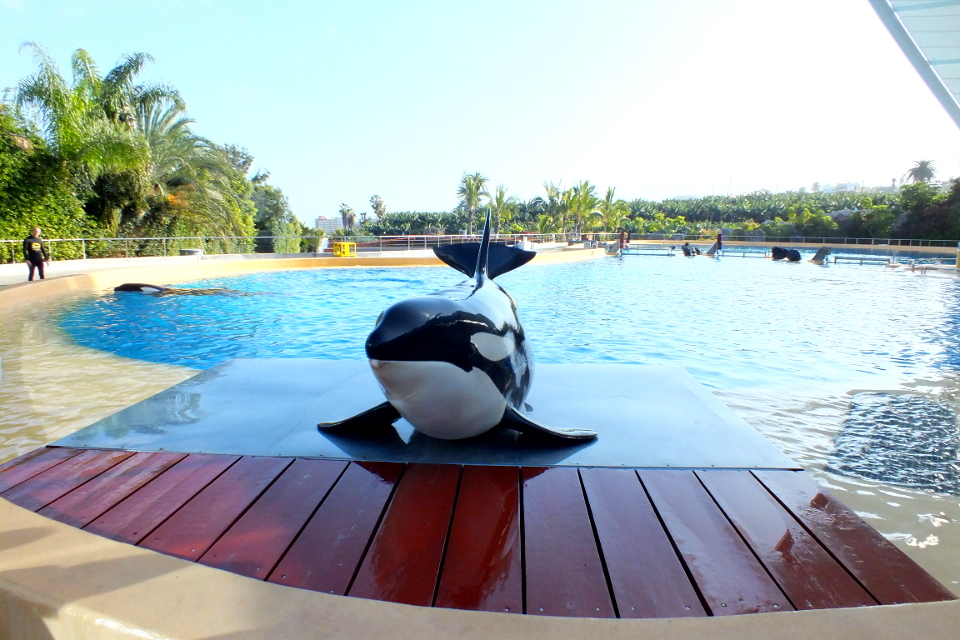Published on zoos.media on the 12th of April in 2018. | By: Robin de Vries in cooperation with Sander Gielen
There is often something to read in the media about the orca lady Morgan living in Loro Parque. This article deals in detail with the question how the animal is doing.
Orca Morgan, the oblivious martyr?
Who is Morgan?
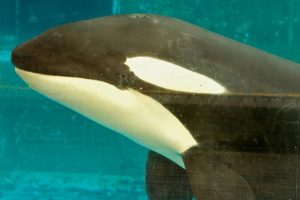
Morgan is a female killer whale or orca (Orcinus orca) that currently resides at Loro Parque, Tenerife located at the Canary Islands. She was rescued by “Dolfinarium Harderwijk’, a Dutch Marine park on June 23 2010 after being found alone and extremely malnourished in the waters of the Wadden Sea.
About a week before her rescue the first reports came in of “a large cetacean” spotted in the waters around Lauwersoog in the Netherlands. Sightings of orcas in Dutch waters are not unheard of but quite a rare occasion as opposed to the more native species of marine mammal found in that specific area. Not long after that the first footage of Morgan appeared, recorded by a boat of the Dutch state. Finally she was confirmed to be an orca and the Dolfinarium in Harderwijk was contacted to set up a rescue plan for the animal as they had the experience and facilities suited for such an operation.
She was completely emaciated weighing just 430 kg while measuring 3,57 meters in length when she came to Dolfinarium Harderwijk. (a normal healthy weight for an orca of that length lays at a minimum of around 660 kg according to the vet at that time!) Her age was estimated to be around 2 or 3 yearsold. Body fat was almost completely absent and she suffered from pneumonia. It was clear this animal was on the verge of death and many experts believed she would not make it through her first week.
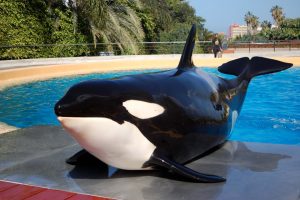
The protocol for rescued marine mammals is to attend to their health problems, then to start the rehabilitation process and the ultimate goal is to release the animal back into it’s natural habitat. Thishowever is not always possible. This can have a number of reasons, for example: persistent health problems, disability of the animal or lack of experience to survive in the wild due to young age. In Morgan’s case it was decided by independent experts that she could impossibly survive on her own in the wild as orcas live in complicated social structures and especially for young animals this is essential for their survival. Integrating her into a random group of wild orcas was deemed too high of a
risk and an also unrealistic procedure. Efforts were made to locate the exact population she was from. Some of the methods used were taking DNA samples, sound samples and pictures of her dorsal fin tomatch these with the existing database of studied populations. Sadly all efforts failed. The next step was to find a new permanent facility for her where she could live among others of her species.
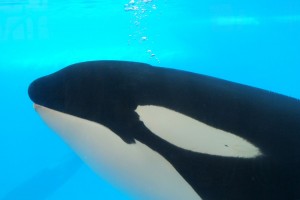
The intention to keep her in captivity caused a lot of controversy around the world and is currently still a very sensitive topic to many. Several animal rights groups stood up and questioned the marine park’s intention, “The Free Morgan Foundation” being one of the main groups playing a part in this. Soon after she was deemed non-releasable, Loro Parque was chosen as her new location. This is when the protests began to rise to a bigger extend. Animal activists stood outside the park with banners and megaphone and handed out flyers to park visitors. Even threats were made to the park and its employees as they were accused of being animal abusers and murderers. Despite this they
gained a lot of followers and eventually even took to court. The outcome of this (and several other court cases filed after that) was again that Morgan would not be able to survive in the wild.
The move to Loro Parque took place on November 29, 2011. It was a very smooth integration; As of January 19 2012 she had contact with the entire group and socialized with all animals To this day Morgan resides at Loro Parque, where she participates in research as well as shows and education. The Free Morgan Foundation continues their efforts to get Morgan away from Loro Parque’s care and eventually released into the wild.
Hearing impairment
Already before she came to Loro Parque her caretakers suspected Morgan might have had hearing problems as she was unresponsive to sounds. Several different occasions of hearing tests and acoustic research have been done since she arrived in Loro Parque which confirmed Morgan is actually deaf. This turned out to be an even bigger argument that she would be unable to survive in the wild as well as a possible reason why she might have lost her original pod in the first place. Ever since her hearing impairment was discovered different training methods were implemented for Morgan using lights rather than sounds. The other orcas have actually learned to respond to these as well.
What is Loro Parque?
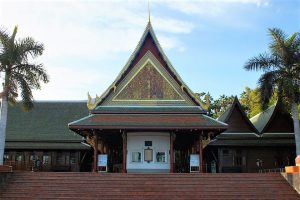
Loro Parque is a zoological facility located at Puerto de la Cruz in Tenerife, at the Canary Islands. Loro Parque was founded in 1972 by Wolfgang Kiessling who remains to this day as the acting president of the park. The park was originally intended to be a refuge for parrots, but today it is a world reference for endangered species and environmental awareness. Loro Parque is one of the leading zoos when it comes so conservation and nature protection. Located at the park is the “Animal Embassy” the headquarters of the “Loro Parque Fundación” which is a foundation of which Loro Parque itself covers all the operating costs. In 2017 Loro Parque became the first European facility to
receive the “humane certificate” given out by the American Humane Association. This is the world’s largest certifier for the humane treatment of animals.
The park has been housing orcas since 2006, when four animals (two males and two females) arrived from two of the three Seaworld parks in the United States of America. The orcas are housed at a facility named “Orca Ocean” which is 120 meters long, 12,5 meters deep and houses 22 million litersof sea water which is obtained directly from the Atlantic Ocean. Currently six orcas live at this enclosure. Among them are the original four animals named Keto, Kohana, Skyla and Tekoa. There is Adán, a calf born to Kohana and Keto in 2010 and the first baby orca in Spain. The final animal being Morgan who joined to group in 2011.
The Loro Parque Fundación
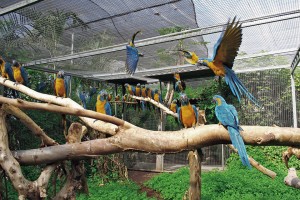
The Loro Parque Fundación is a non-governmental organization founded in 1994 by Wolfgang Kiessling. It operates on an international level on conservation and the protection of wildlife. 100% of the donations that the foundation receives goes to the protection and conservation of wildlife and natural habitats. Over the years they have carried out 109 initiatives in over 30 countries with an investment of over 18 million dollars.
Parrots and cetaceans are the main subjects of the foundation. Including several projects on the research, conservation and protection of wild orcas. Examples of these projects are the conservation of orcas in the Straits of Gibraltar by reducing orca-fisherman conflicts, analysis
of the call sequence of orcas, toxicity in wild killer whales and the effect of contaminant cocktails on orcas and other marine mammals as well as the first non-invasive tagging method for cetaceans. In all these examples the resident orcas at Loro Parque play a very important role, making these research studies and conservation efforts possible.
Thanks to the efforts of the Loro Parque Fundación 9 species of parrots were actually saved from extinction in the last few decades. With some species growing from only 22or 87 remaining animals in the wild to several thousand individuals.
The five principles of Loro Parque
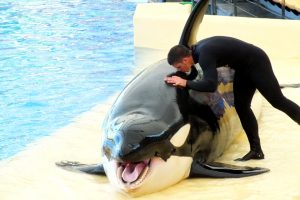
Because of constant attacks and accusations of animal right extremists as well as to guarantee a better understanding within society Loro Parque operates under the “five principles of Loro Parque”. These include:
- Care for the animals with absolute love and respect to guarantee their welfare and dignity.
- Allowing the animals under our care the five freedoms (Animal Welfare Council 1979) which are freedom from hunger and thirst, freedom discomfort, freedom from pain, injury and disease, freedom from fear and distress and freedom to express normal natural behaviors (which includes reproduction).
- All animals residing at Loro Parque are considered ambassadors for the conservation of their own kind within their natural habitats.
- Loro Parque supports activities to research and conserve threatened species under human care and in natural ecosystems.
- Loro Parque considers itself a sanctuary for wild animals that are in need of help.
Morgan’s Pregnancy
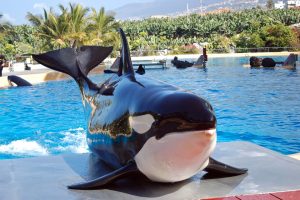
On December 3, 2017 it was confirmed to the public that Morgan is pregnant. Dr. Jorge Soares, veterinary director of Loro Parque confirmed this with a statement. This again sparked up a lot of controversy from all kind of parties, especially animal rights groups and animal activists. Through the years these have reported numerous times that Morgan has health problems, is attacked and harassed by the other orcas and is even being mistreated. Loro Parque however has reacted on these statements as being false. Apart from Loro Parque’s medical team several independent vets and researchers have been examining Morgan during the time she has been in Loro Parque to back up this statement. One of which is Andrew G. Greenwood who released an official health assessment online in 2013 stating Morgan was in excellent health.
In the last six years I have been to Loro Parque myself numerous times to witness the status and treatment of Morgan, both behind the scenes as well as a normal visitor. I have yet to conclude any of the accusations mentioned above. In light of the latest claims on Morgan’s wellbeing, her pregnancy and with yet another court case filed by animal extremists, I decided to come and visit her again together within a small team of two. The goal; witness and record what we would see upon visiting Morgan again as well as to talk with several of the experts at Loro Parque to clarify uncertainties among the public. The following report and interview is the result of this visit.
We had the opportunity to talk with Dr Javier Almunia, Director of Environmental affairs and essential contributor of several research studies regarding orcas about Morgan’s pregnancy and subjected him to the following questions:
How old is Morgan currently and how was this confirmed?
Dr Almunia: “It is impossible to know her exact age seeing as she was already several years old when she was found. Because of this it will always be an estimate. We have however compared several statistics of the growth rates in orcas both in the wild and in Loro Parque to come with an estimate of around 10 or 11 years as her current age. When she was rescued she was estimated to be 2 or 3 years old. At that time she was however heavily malnourished and probably much smaller than she was supposed to be. a more accurate age at the time of her rescue would be between 3 or 4 years”.
For how long has Morgan been pregnant?
“We discovered her pregnancy in November 2017 and it was estimated that she was around 5 months pregnant at that time. We expect her to give birth near the end of 2018”.
How did Morgan become pregnant?
“It was a natural mating. We do not practice artificial insemination at Loro Parque. The father is at this time unknown as it was a spontaneous act when the animals were socializing and it happened outside of our observations”.
How did you find out Morgan was pregnant?
“During a regular routine actually. We use ultrasounds to monitor the cycle and ovaries of the females, a small fetus was discovered during this. It was only discovered after 5 months because the uterus is very large and the large amount of body fat on orcas distorts the ultrasound which makes it easy to miss something. Especially when it is not the main focus to look for a fetus.”
Do you not check for hormone levels in the female orcas?
“We do not include hormone checks as a medical routine as breeding is not our focus. We do observe the cycle of the females so we can separate them from the males in their fertile period. This way we do not have to distribute birth control medication to them, which can possibly be harmful on a long term. Yet they are able to display their natural behavior”.
Was the pregnancy planned?
“No, absolutely not. We did want to give Morgan the chance to be a mother in the future, as this is an important part of the animals natural behavior. However we had the intention on waiting a couple more years before expanding our group of orcas”.
Is it true that you were actually not allowed to breed her and agreed to that when receiving Morgan?
“It is absolutely not true that there are any limitations to breeding Morgan. This is a lie spread by animal right groups to make their argument stronger. The Free Morgan Foundation actually received a clarification from the Spanish government that there are no limitations for Loro Parque in the housing and keeping of Morgan, yet they continue to spread this lie. We have the documents to prove this and are happy to hand this out to anyone interested”.
Is there enough space for another orca?
“There is more than enough space for Morgan to have a baby and for this calf to grow up. We are far from reaching the limit of space available for our animals”.
Are the rumors of a possible expansion true?
“There was a realistic plan to expand the pool system of the orca habitat. This was planned to happen in a few years. However with the current pregnancy this was put on-hold. Construction close to a pregnant animal and growing calf could be stressful and we want to avoid that”.
Can Morgan’s deafness play a role as a possible complication?
“We really do not know if Morgan’s deafness is something she had since birth and if it can be genetically transmissible. It is possible, but there several other possibilities such as trauma, sonar or even a pathogenic cause like a bacterial infection that caused her hearing impairment. So it is impossible to know at this point if the calf will display something similar”.
Could her deafness restrict the caretaking of the calf?
“It might happen that the calf has difficulties in understanding and interpretation of the dialect because Morgan also doesn’t. Unless the other orcas will have a role in this. This however will have a huge value research-wise. There are already scientists who showed interest in the development of the calves learning curve for the dialect. It will be very interesting to see if the dialect is taught mainly by the mother of an individual or by the entire pod”.
What are the risks that this pregnancy brings?
“As a first time mother there might be a possibility Morgan will not know how to handle the calf. If this is the case we have a professional team with a lot of knowledge and experience in hand rearing orca calves. Two of our calves born here were unfortunately rejected by their mother, so we needed to step in and manage the caretaking of the calves ourselves. Both of these times it was successful. One of the calves named Adán is still living here today, the other calf was named Vicky who unfortunately passed away due to intestinal problems. These were however not related to birth complications or the hand rearing process. So we consider both occasions very successful. Births in orcas and marine mammals in general are always high-risk. Even in the wild 52% of the calves will not reach their first year. This is however a rough estimate as it is hard to tell in the wild when an orca is pregnant and if the pregnancy failed or not. The main cause is because of the low immune system calves display when theyare newborn. We will do everything in our power to assist Morgan and guarantee the calves survival.”
Observation
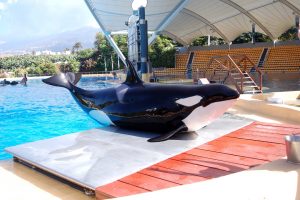
We were allowed to visit the orca habitat behind the scenes during the morning and afternoon to witness the routine of the trainers and orcas, one of which being medical training sessions. During the routines we witnessed many occurrences of social behavior between Morgan and the other orcas. She was grouped with different animals through the day. The orcas participated in training, medical training, shows and also had periods where they got their “free time” and were able to do swim freely and choose freely which behaviors to display and which animals to socialize with. Even during this free time Morgan never appeared to be swimming alone. She seemed to prefer the company of Adán, the youngest orca of the group the most. Morgan appeared very active both in general behavior as socially, yet her behavior was in a calm matter. Whenever a trainer appeared she seemed very interested and alert.
During the course of the day we observed various medical routines practiced by the trainers and veterinarian staff. Among these were taking a urine sample as well as a blood sample from Morgan. We also witnessed the attendance of Morgan’s oral health during which her teeth were disinfected. Both wild and captive orcas show tooth wear because of interactions with other orcas and their surroundings. This is monitored closely and treatment is given when necessary. Morgan stayed very calm during all these procedures and did not show any sign of stress or pain. She was rewarded afterwards.
Medical training
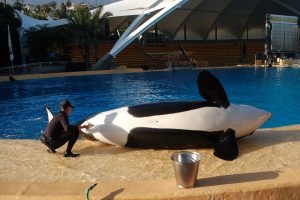
The most important training regarding the care of animals is the medical training. These are a number of medical routines that are practiced regularly creating the possibility to monitor an animal’s health voluntarily. Even voluntary treatment is possible thanks to this training. An example of the medical procedures of the orcas at Loro Parque are taking blood samples, urine samples, a sample of the exhalation of the blowhole, ultrasounds, measuring the animals, weighing the animals and a check-up of the physical health of the animal (eyes, teeth etc,). By practicing these routines regularly the orcas get used to these procedures which makes it more efficient to monitor and maintain the animals health.
Medical training is used by many zoological facilities on a lot of different species. The medical training used on dolphins and orcas however is very advanced and one of the most stress-free methods existing today. The orcas work in direct contact with their caretakers and they do not have to be sedated or restrained for physical check-ups, minor treatments, blood sampling or even transportation. As the animal is rewarded via the positive reinforcement method is it unlikely to link negative experiences or emotions to these routines.
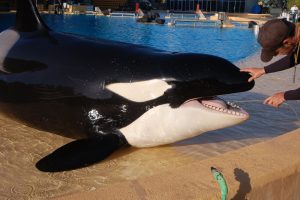
During these training sessions it became very clear that Morgan was used to these medical routines as she seemed to understand what was asked from her. She appeared very calm and waited for the signals of the trainers as she displayed the asked behaviors. We were able to see her entire body numerous times as it is still safe for her to come completely out of the water to be weighed. Her skin appeared smooth with some superficial scratches. No wounds, deep scars or fresh rakemarks were visible. Her weight on the scale was between 2200 to 2300 kilograms with 2324 kg being the highest recorded weight at the time of our visit.
Positive reinforcement
The training process of the orcas and dolphins at Loro Parque is in every way reached with the “Positive Reinforcement” method. Most people may already be familiar with it as the most well-known variation of this method is the so called “clicker training”, which is very popular in pets. The basic principle of this method is to reward the animal for a desirable behavior. When the animal displays an undesirable behavior it is ignored instead of correcting it or giving it punishment. Then the behavior is asked again. The main purpose of this training method is to have the animal displaying desired behaviors without experiencing negativity such as stress, fear or aggression. The method is very successful as the animal only experiences positive or neutral stimuli. Therefore it is used on hundreds of species today of which mammals, birds, reptiles, fish and even insects!
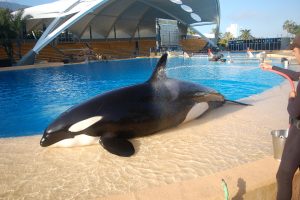
The key to marine mammal training is to use a signal that clarifies to the animal they are displaying the desired behavior and that a reward is following. This signal is used in the form of a high frequency whistle. The reward is mainly food as this is instinctively a highly positive stimulus for animals, but this certainly not always the case. The orcas at Loro Parque are also rewarded with things such as a toy, gelatin, ice cubes, water sprays or the enthusiasm of their trainer, (similar to for example dog training). During our stay we also observed Morgan being rewarded with this so called “Secondary Reinforcement” rewards.
We returned at a random day as normal park guests to find out if there was anything different from our observations during the first visit. We didn’t conclude any. The period before, during and after the shows the back-pools are visible for the public. Several medical training sessions and free-time sessions could be observed at the from the audience grandstand. Morgan was not even used in every show, as many activists claim. In fact she only had segments in one of the four shows that day and mostly swam freely in the back-pools during others.
Overall Morgan seemed like a normal, healthy orca that did not display any abnormal or atypical behavior just like in previous visits. We have witnessed her socializing with both the other orcas and her trainers. We were happy to conclude that the current accusations made by several animal right groups are once again wrong.
